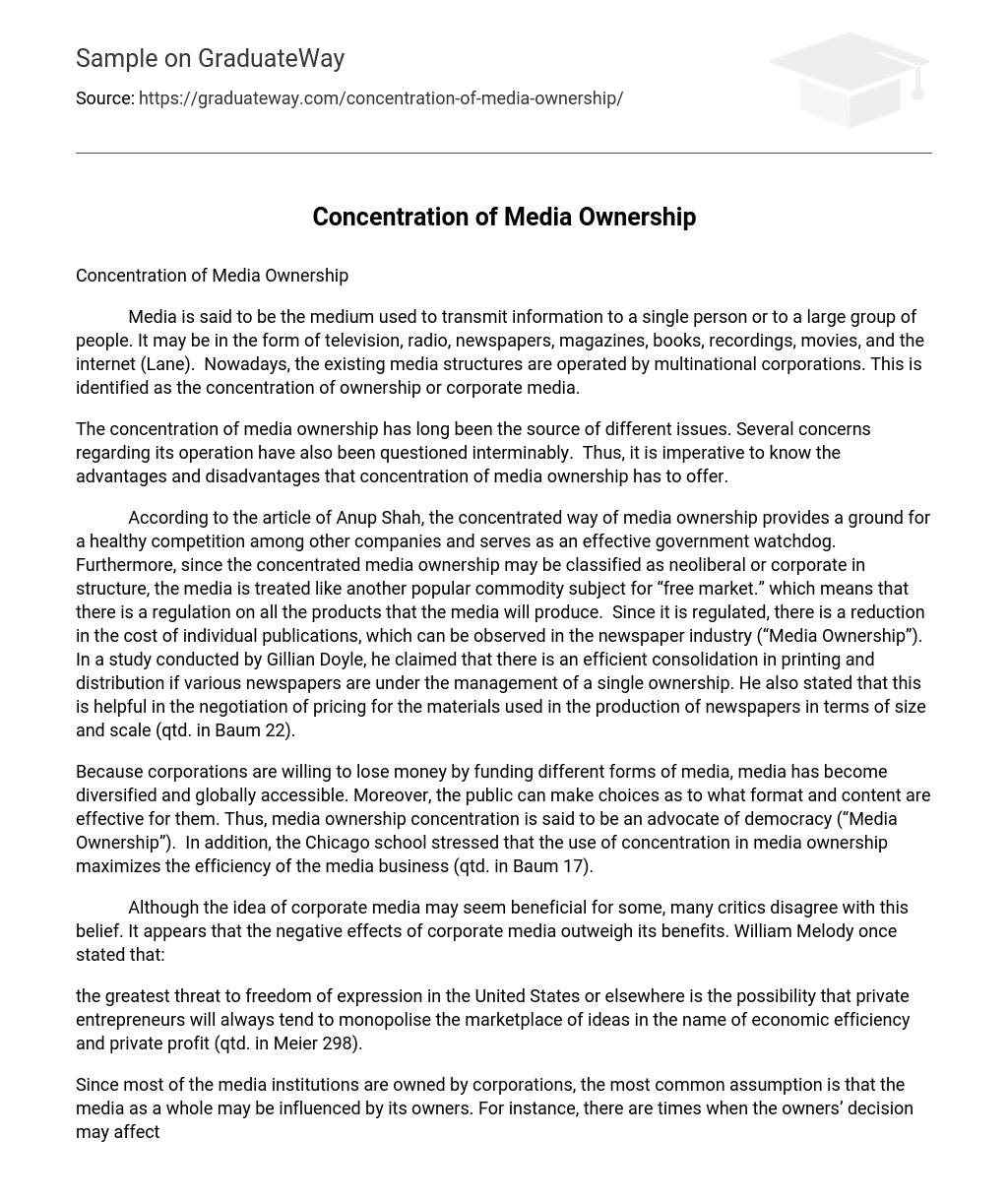Media is said to be the medium used to transmit information to a single person or to a large group of people. It may be in the form of television, radio, newspapers, magazines, books, recordings, movies, and the internet (Lane). Nowadays, the existing media structures are operated by multinational corporations. This is identified as the concentration of ownership or corporate media.
The concentration of media ownership has long been the source of different issues. Several concerns regarding its operation have also been questioned interminably. Thus, it is imperative to know the advantages and disadvantages that concentration of media ownership has to offer.
According to the article of Anup Shah, the concentrated way of media ownership provides a ground for a healthy competition among other companies and serves as an effective government watchdog. Furthermore, since the concentrated media ownership may be classified as neoliberal or corporate in structure, the media is treated like another popular commodity subject for “free market.” which means that there is a regulation on all the products that the media will produce. Since it is regulated, there is a reduction in the cost of individual publications, which can be observed in the newspaper industry (“Media Ownership”). In a study conducted by Gillian Doyle, he claimed that there is an efficient consolidation in printing and distribution if various newspapers are under the management of a single ownership. He also stated that this is helpful in the negotiation of pricing for the materials used in the production of newspapers in terms of size and scale (qtd. in Baum 22).
Because corporations are willing to lose money by funding different forms of media, media has become diversified and globally accessible. Moreover, the public can make choices as to what format and content are effective for them. Thus, media ownership concentration is said to be an advocate of democracy (“Media Ownership”). In addition, the Chicago school stressed that the use of concentration in media ownership maximizes the efficiency of the media business (qtd. in Baum 17).
Although the idea of corporate media may seem beneficial for some, many critics disagree with this belief. It appears that the negative effects of corporate media outweigh its benefits. William Melody once stated that:
the greatest threat to freedom of expression in the United States or elsewhere is the possibility that private entrepreneurs will always tend to monopolise the marketplace of ideas in the name of economic efficiency and private profit (qtd. in Meier 298).
Since most of the media institutions are owned by corporations, the most common assumption is that the media as a whole may be influenced by its owners. For instance, there are times when the owners’ decision may affect the kind of information that media would disclose to the public. According to some media observers, in the United States alone, the powerful owners of some media institution control what the people should read, hear, and see (Meier 300). Consequently, by omitting stories and being biased, the high quality of journalism is compromised. This suggests that the suppression of the so-called “freedom of expression” is prevalent among the corporate owned media institutions. Apart from this, there is also standardization in the content, provision, packaging, and distribution of the media product. One of the best examples of these is the editorial consolidation in the newspapers. If a newspaper is under a corporate media and can have a better coverage of a particular story, the other groups of newspaper under that corporation could use that same coverage and simply “re-package” it. According to Neumann, as a result of this standardization, everything that the people can see and hear is already uniform in content, which opposes the proponents of diversity and democracy (qtd. in Meier 298).
Another criticism of the corporate media system is the excessive airing of advertisements. All media institutions survive through advertising fees. Take for example the television. In order to compensate for the amount of money that the advertisers paid, product advertisements appear every several minutes. Because of the numerous advertisements, the enjoyment of the viewers is minimized (“Media Ownership”).
Other major drawbacks of the media ownership concentration include: (1) the lack of attention for the local media wherein coverage for local sports, elections, and gossips are taken for granted because the media corporations are more focused on bringing content around the globe; and (2) the treatment of media as a popular commodity which implies that a higher demand results in an increase in production. For instance, many parents would complain about programs which contain sex and violence because it is not suitable for children. Yet, it appears that media owners would continually produce programs with sex and violence as long as the demand for them is high (“Media Ownership”).
In this media-driven world, the power that media corporations wield is very evident. They create a huge impact not only on the whole industry but the society as well. Hence, it is highly important to conduct an in depth analysis on the role of large companies, mergers, and conglomerates in the media ownership concentration in order to properly address the underlying issues within the topic. Furthermore, it is essential for the media corporations to create a system that would secure democracy and the interest of the public.
Works Cited
Baum, Ido. “The impact of ownership concentration in the media business on the quality of information delivered to the consumer.” European Master in Law and Economics.
10 July 2008 <http://rile.brinkster.net/Thesis/baumido.pdf>
Lane, Beth. “What is mass media? The changing role of mass communications and the media industries.” Media literacy suite 101. 29 June 2007. 10 July 2008 <http://medialiteracy.suite101.com/article.cfm/what_is_mass_media_ >.
“Media ownership.” Everything 2. 5 July 2002. 10 July 2008 <http://everything2.com/index.pl?node_id=1327440>.
Meier, Warner. “Media ownership-does it matter?” Networking Knowledge Information
Societies: Institutions & Intervention. Ed. Mansell, Robin, Samarajiva, Rohan &
Mahan, Amy. Netherlands: Delf University Press, 2002. 298-302.
Shah, Anup. “Media conglomerates, mergers, concentration of ownership.” Global Issues. 29
May 2007. 10 July 2008 <http://www.globalissues.org/HumanRights/Media/Corporations/Owners.asp>.





